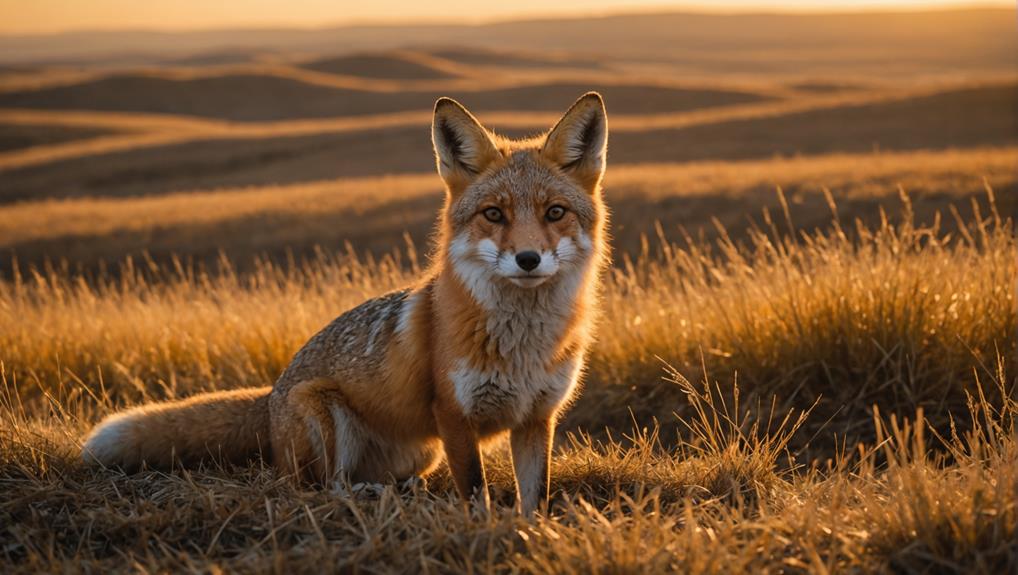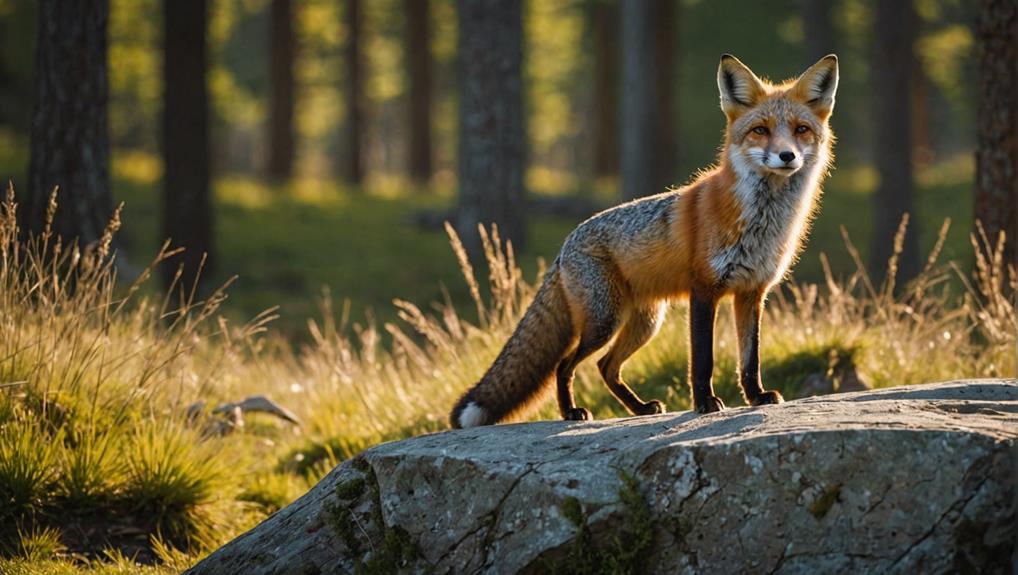When you think of the best foxes in North America, you'll find five enchanting species that all have their own tricks up their furry sleeves. First, there's the Red Fox, an adaptable hunter roaming from forests to cities. Next, the Gray Fox surprises folks with its tree-climbing skills! Meanwhile, the Arctic Fox rocks its winter wardrobe while thriving in icy spaces. Don't forget the Kit Fox, the smallest of the bunch, who's a master of stealth in the desert. Finally, the Swift Fox zips around the prairies like it's participating in an agility contest! Curious about their unique traits? There's more to explore!
Contents
Red Fox: The Adaptable Canine
When you think of foxes, the Red Fox (*Vulpes vulpes*) often comes to mind as the most recognizable species in North America. This adaptable canine isn't just a pretty face; it's a survivor.
Weighing between 8-14 pounds, the Red Fox can thrive in many habitats, from forests to urban areas, showcasing their remarkable adaptability in diverse environments. Talk about versatility!
These clever creatures are solitary hunters, relying on their keen senses and agility to stalk small mammals, birds, and even fruits when the going gets tough. They've got a varied diet that keeps them on their toes, scavenging for food when necessary.
Imagine being a fox, sneaking around, hoping to catch a quick meal—sounds like a thrilling life, right?
Red foxes reach sexual maturity by one year, typically mating in late winter. Their average litter size is about four kits, born in the lovely spring months of March or April. It's a busy time for these crafty critters!
Gray Fox: The Tree Climber
While the Red Fox may be the poster child for adaptability, the Gray Fox (*Urocyon cinereoargenteus*) brings its own unique skills to the table. As the only fox capable of climbing trees, this nocturnal hunter has some impressive tricks up its furry sleeve. With strong wrist structures and sharp claws, it expertly navigates wooded habitats.
| Feature | Gray Fox |
|---|---|
| Size | 7-12 pounds |
| Coat | Grizzled mix of gray and red |
| Habitat Preference | Tree hollows & rock crevices |
| Prey | Small mammals, birds, insects |
This climbing prowess allows the Gray Fox to find safe denning sites, enhancing its stealth when hunting small mammals and birds. You might spot one in your backyard, adapting to urban environments with ease! Their grizzled coats help them blend into the forest, making them skilled predators.
Arctic Fox: The Tundra Specialist

The Arctic fox's remarkable adaptations make it a true specialist of the tundra. With its thick fur and a layer of fat, it stays cozy even in the coldest temperatures.
This little creature undergoes a stunning transformation, changing from brown in summer to white in winter, which helps it blend seamlessly into the snowy landscape. Talk about camouflage! Their keen senses allow them to detect food hidden beneath the snow, showcasing their incredible adaptability.
When winter rolls in, the Arctic fox relies on scavenging, picking up leftovers from larger predators' meals. But during the summer months, it shifts gears to hunt small mammals like lemmings and rodents.
These nimble hunters have a compact body design, which not only makes them adorable but also aids in conserving warmth. You can find Arctic foxes roaming the Arctic tundra regions of North America, especially in Alaska and Canada.
They cover extensive home ranges, always on the lookout for their next meal or a cozy spot to curl up. So, next time you think about the tundra, remember this incredible little fox and its amazing adaptations. It's a true survivor in one of the harshest environments on Earth!
Kit Fox: The Desert Dweller
Shifting from the icy expanses of the Arctic, the Kit Fox offers a fascinating contrast as a true desert dweller. Found primarily in the southwestern United States and northern Mexico, this little guy, scientifically known as *Vulpes macrotis*, is the smallest fox species in North America.
Weighing only 4 to 6 pounds and standing about 12 inches tall, the Kit Fox is perfectly adapted to its surroundings. You'll often find them emerging at dusk, ready for a nocturnal adventure. During the day, they prefer to stay cozy in their burrows, avoiding the heat.
With their long ears, which can stretch up to 4 inches, they not only look adorable but also use them to regulate their body temperature and listen for small mammals and insects—perfect for their dinner plans!
While Kit Foxes are generally solitary, they do form small family groups. Their unique communication skills, including a chatter that's downright charming, help them bond and stay connected.
Swift Fox: The Prairie Hunter

In the vast expanse of the Great Plains, you'll encounter the Swift Fox, a small but agile hunter known scientifically as *Vulpes velox*. Weighing in at just 5 to 7 pounds, this feisty little canid is a master of evasion and speed, making it an expert at catching small mammals and insects.
Red foxes, including their swift cousins, demonstrate exceptional adaptability by thriving in diverse environments and utilizing available resources effectively, showcasing their role in habitat diversity. Picture this: a nighttime stroll through the prairie, and suddenly, you spot a swift fox darting gracefully across the grass, a true prairie hunter!
These foxes aren't just solo performers. They thrive in social groups with female-based territories and often engage in cooperative breeding, where multiple adults pitch in to raise a litter of 2 to 6 kits. Isn't that sweet?
They prefer to call burrows—often abandoned by other animals—their home, ensuring they've a cozy spot to rest.
Sadly, habitat loss and hunting once put the Swift Fox in jeopardy, but thanks to dedicated conservation efforts, they're now classified as a species of Least Concern.
Final Thoughts
So, there you have it! North America is home to some pretty amazing fox species, each with its own unique charm. Whether you're marveling at the clever red fox or the agile gray fox that can climb trees, there's so much to appreciate. From the snowy Arctic to the sunny deserts, these furry friends adapt beautifully to their homes. Next time you're outdoors, keep an eye out—you never know when a sly fox might just pop up to say hello!














